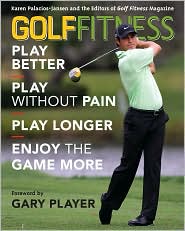Christie Kerr’s wrist injury during this year’s Solheim Cup may have cost the Americans the Cup.  Obviously she felt horrible that she could not participate the last day, but could her injury have been avoided? Read about how to avoid the most common golf injuries in my new book Golf Fitness available on Amazon.com.
Obviously she felt horrible that she could not participate the last day, but could her injury have been avoided? Read about how to avoid the most common golf injuries in my new book Golf Fitness available on Amazon.com.
The 10 Most Common Golf Injuries
Golf requires a lot of time and effort, not to mention a great deal of skill, mental fortitude and perseverance to excel at it. The explosive nature of the swing can put a tremendous amount of stress on the body, and a majority of professional golfers have experienced some sort of nagging injury at one time or another in their careers. But you don’t have to be a professional to experience some of the most common injuries in golf. Even casual golfers can sustain injuries. Many injuries can be prevented.
Experts in sports medicine note a number of factors that contribute to common golf swing injuries:
· Overuse and over practice
· Poor swing mechanics
· Over-swinging
· Not warming up the muscles before play
· Rotational stresses placed on the spine
· Incorrect grip and set-up
· Traumatic force to the body resulting from a poorly executed swing
These factors can lead to the most common injuries:
1. Back Pain – An estimated 75 to 85 percent of all Americans will experience some form of back pain during their lifetime, and the numbers may be higher among golfers. The rotational stresses of the golf swing can place considerable pressure on the spine and muscles. Compound that with the fact that golfers spend 4 to 5 hours in a bent-over stance, repeating the same motion hundreds of times, it is no wonder that playing golf can cause minor strains in the back that can easily lead to severe injuries. To keep your back healthy for golf, add exercises that stretch and strengthen your back.
2. Tendonitis in the Elbows – Tendonitis (irritation and inflammation of the tendon tissue) is the most common condition affecting the elbow. It is frequently referred to as “tennis elbow” when there is an injury to the outer tendon, and “golfer’s elbow” when there is an injury to the inner tendon. Interestingly enough, most golfers suffer more from “tennis elbow” than “golfer’s elbow.” The risk of getting tendonitis increases with age, and is higher in people who routinely perform activities that require repetitive movements that increase stress on susceptible tendons, such as hitting golf balls. In addition, even with less repetition, these type of injuries can be aggravated by an improper swing motion.
Treatment focuses on resting the injured tendon to allow healing, decreasing inflammation, promoting muscle strength, and improving improper swing mechanics. In most patients, tendonitis readily resolves with treatment.
3. Knee Pain – Knee pain can occur from the strain placed on a weak knee to stabilize the rotation of the hip axis at the beginning of the swing. Extreme force placed on the knee can result in torn ligaments. Arthritis sufferers may experience more knee problems because the degenerative nature of the disease, which results in a gradual wearing away of joint cartilage.
Treatment of knee pain depends entirely on the cause of the problem. So if you are experiencing symptoms, you must see a doctor. Stretching, rest and icing to bring down inflammation can all help alleviate symptoms.
4. Rotator Cuff – Pain may be felt in the shoulder or upper arm at various phases of the golf swing, or following play, often during the night and when extending arms overhead. Injuries to the rotator cuff can be sustained through traumatic force resulting from a poorly executed golf swing, hitting a root or rock, taking a deep divot, and from overuse. Golfers can develop tendonitis, bursitis, and tears in the rotator cuff due to the repetitive motion of the golf swing.
Rotator cuff injuries are usually treated with anti-inflammatory drugs. In some instances, surgical repair becomes necessary. In these cases, modifications to the golf swing, combined with strength conditioning could alleviate symptoms and prevent further injury.
5. Wrist Injuries – The repetitive motions of golf, and the high speed of the typical golf swing can place wrists at a high risk for injury. Pain and tenderness on the top of the wrist, experienced at the top of the backswing and at impact, are common. The most common golf-related wrist injury is tendonitis, or swelling of the tendons responsible for wrist movement. Many wrist injuries, as well as other golf-related injuries, can be prevented by performing a pre-season and year-round golf-specific conditioning program.
To Read More-buy my new book Golf Fitness.

Share this Post
